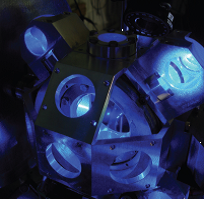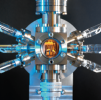Links
High accuracy optical clocks with trapped ions
This EMRP-funded project addressed the development of highly precise optical clocks using laser-cooled trapped ions. Its aims were to evaluate systematic uncertainties and stabilities across a range of ion species, and to improve clock performance through new interrogation methods for single and multiple ions. The optical frequency ratio measurements and absolute frequency measurements performed within the project fed into the analysis carried out within WP5 of the ITOC project.
OC18: Optical clocks with 1×10-18 uncertainty
This EMPIR-funded project aims to further improve optical clock technology in order to achieve lower instabilities and to reduce systematic uncertainties to the level of 1×10-18. Building on the work performed in the ITOC project, the performance of the optical clocks will be validated through direct frequency comparisons.
Accurate time/frequency comparison and dissemination through optical telecommunication networks (NEAT-FT)
In this EMRP-funded project, new techniques were explored for phase-coherent comparison of optical clocks separated by distances of up to 1500 km. The project included a study of the fundamental limitations of optical fibre links to the attainable instability and accuracy of optical reference frequencies and timing signals. The aim was to reduce the contribution of the link to the relative uncertainty of a frequency comparison to a level significantly below that of the clocks involved. The outputs from this project were exploited within WP4 of the ITOC project.
OFTEN: Optical frequency transfer – a European network
Building on the work performed in NEAT-FT, this project will address the need for reliable operation of optical fibre links on an autonomous, day-to-day basis so that they can be used for optical clock comparisons on demand. This requires further improvement of equipment and a deeper understanding of the noise processes limiting the stability of an optical fibre link, as well as the development of real-time evaluation tools for multiple clock comparisons. The work performed will improve upon the comparison uncertainties achieved within the ITOC project, enabling multiple optical clock comparisons to be formed at a fractional instability level in the 10-17–10-18 range.
SOC2: Towards Neutral-atom Space Optical Clocks
Mutually beneficial interactions have taken place with the consortium of this EU Framework 7 project. Both WP2 of the ITOC project and the SOC2 project were concerned with the development of transportable optical clocks. However, the emphasis of the ITOC project was on the pure metrological goals of accuracy and stability, whereas in SOC2 the restrictions on mass, size and power consumption imposed by the background of space applications were of paramount importance.
Atomic Clock Ensemble in Space (ACES)
In the ACES mission, a laser-cooled microwave atomic clock on board the international space station will be compared to an international network of ground-based clocks to perform tests of general relativity and alternative theories of gravitation. The outputs of the ITOC project will benefit ACES by assessing the performance of the clocks that will be involved in the ground-based part of the mission. The optical clocks and time and frequency transfer methods will also be invaluable for characterising the performance of the space-to-ground time transfer system that will be used in ACES.
STE-QUEST mission
High accuracy ground clocks and methods for their comparison would also benefit this proposed space mission, which is designed to test the Einstein Equivalence Principle to high precision and to search for new fundamental constituents and interactions in the Universe.

The research within this EURAMET joint research project receives funding from the European Community's Seventh Framework Programme, ERA-NET Plus, under Grant Agreement No. 217257.

